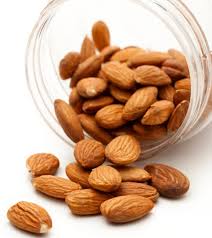Almond Joy
by Cathe Olson
Almonds are a vegan super food. They are a good source of protein, essential fatty acids, calcium, iron and several B vitamins. It doesn’t hurt that they taste delicious and are extremely versatile. Almonds are yummy on their own as a snack, but they’re also great tossed into salads, stirfries, or pasta dishes. Chop them up and add them to baked goods, sprinkle them over oatmeal, or add them to brown rice and other cooked grains. Almond butter is a nutritious (and less allergenic) substitute for peanut butter. Homemade almond milk is easy to make and cost just pennies.
Botanically, almonds are actually a fruit—closely related to peaches and apricots. They are grown in temperate climates, with California supplying most of the domestic almonds. To maintain maximum freshness, buy whole (unshelled) almonds and keep them in the refrigerator or freezer. If you are not sure your almonds are fresh, cut one in half. The interior should be solid and white. A honeycomb texture or yellow color indicates that the nut is rancid and should not be eaten.
Serve almonds raw or lightly toasted to get the maximum nutrients. To make them more digestible, soak the nuts in water overnight. Toasting almonds over a low heat in the oven or a dry skillet makes them even more flavorful.
Here are a few almond recipes:
Orange-Almond Salad
This salad supplies calcium and iron, and the vitamin C from the cabbage and orange help them to be absorbed.
1 head romaine lettuce, washed and cut into bite-sized pieces (about 6 to 8 cups)
1 cup shredded red cabbage
1/2 cucumber, peeled and sliced
2 mandarin oranges or tangerines, peeled and split into sections
1/2 cup almonds, coarsely chopped and toasted
Dressing:
6 tablespoons orange juice (1 orange)
1 teaspoon rice or apple cider vinegar
1 1/2 teaspoons soy sauce
1 tablespoon almond butter
1 tablespoon toasted sesame oil
1 teaspoon minced fresh ginger
Place lettuce, cabbage, cucumber, orange, and almonds in large bowl. Whisk dressing ingredients together. Pour over salad a little at a time and toss gently until salad is coated. You may not need all the dressing.
Makes 6 servings
Coconut-Almond Shortbread
These amazing wheat-free treats are so luscious, you won’t believe they’re good for you.
1/2 cup room temperature coconut oil or butter substitute like Earth Balance
2 tablespoons almond butter
1/4 cup agave nectar or brown rice syrup
1/3 teaspoon almond extract
1 cup brown rice flour
1 cup rolled oats
1 cup unsweetened shredded coconut
Preheat oven to 350 degrees. Beat together coconut oil or butter substitute with almond butter, sweetener, and almond extract until smooth. Add remaining ingredients and mix until combined. You may need to use your hands to knead this dough a few times so it will hold together. Place dough on unoiled baking sheet. Press into an 8-inch disk. With sharp knife, cut dough into 12 wedges but don’t separate. Prick each wedge several times with a fork. Bake 25 minutes, or until edges are golden brown. Cool before separating wedges.
Makes 1 dozen
Almond Butter Raisin Chews
Your children will love to shape these sugar-free treats. These keep well in the refrigerator and are perfect for lunchboxes or snacks.
1/2 cup raisins
1/2 cup almond butter
1/3 cup dry soymilk powder
1 teaspoon vanilla extract
1 tablespoon water
Optional: unsweetened, shredded coconut, sesame seeds or chopped nuts
Grind raisins in food processor with metal blade. Add remaining ingredients, and process until smooth. Shape into 16 balls. Roll balls in coconut flakes, sesame seeds, or chopped nuts if desired. Chill.
Makes 16
Note: If you don’t have a food processor, chop raisins by hand, and mix all ingredients in a bowl with your hands.
Almond Milk
You can substitute almond milk for dairy or soymilk in most recipes. You don’t have to soak the almonds but it makes easier for your body to digest.
1/2 cup raw almonds
2 cups water
Liquid stevia extract, maple syrup, brown rice syrup, agave nectar, or natural cane sugar to taste
If desired, soak almonds in water 8 to 24 hours. Drain. Place almonds in blender and grind as finely as possible. (Wet nuts don’t grind as well as dry ones but that’s okay.) Add water and blend until smooth. Add sweetener and blend to combine. Use as is in smoothies, cereals, or cooking. For a smooth drinking texture, pour milk through a mesh strainer. Nut pulp can be added to hot or cold cereal, breads or muffins. (It also makes a great facial scrub.) Keep milk refrigerated. It will keep for about 5 days.
Makes 2 cups
Recipes have been reprinted from The Vegetarian Mother’s Cookbook copyright © 2005 and Simply Natural Baby Foodcopyright © 2003 by Cathe Olson.


